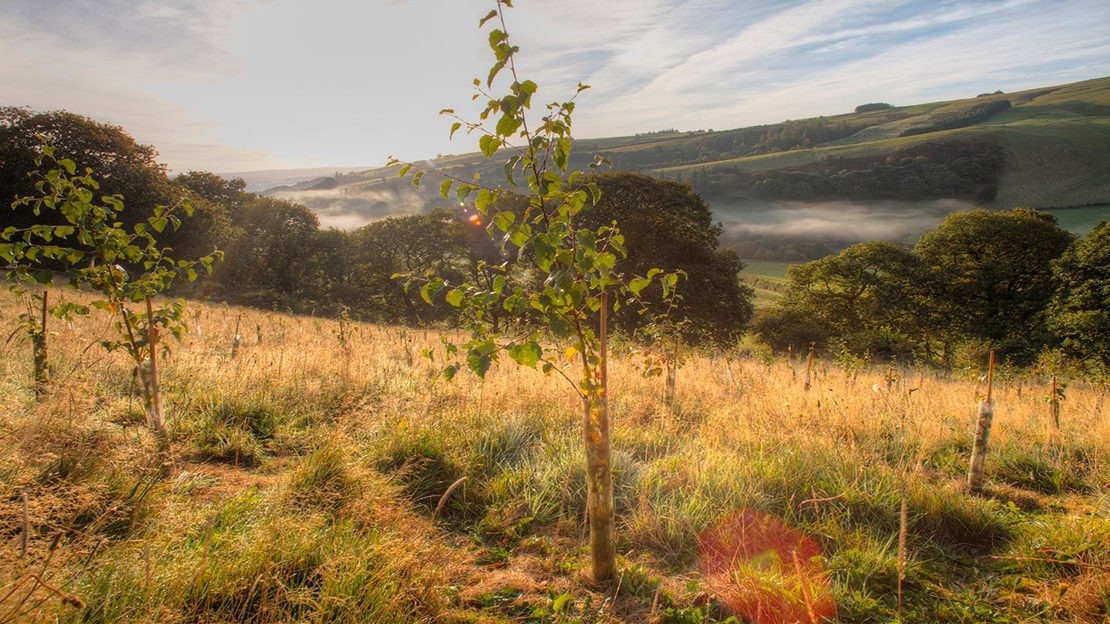Buy British trees from our shop
We have single trees and tree packs to meet your needs, from wildlife to woodfuel. Delivery is free.
Shop nowOnce your trees are in the ground it’s important to care for them to help them thrive, particularly in the first few years.

Make sure everyone involved in maintenance of the space knows where your trees have been planted to avoid mowing or accidental damage.
Weeding is the most important step in giving your trees the right start. Keeping a 1 metre diameter around the tree clear of weeds and grass for the first 2-3 years will reduce competition for moisture and nutrients.
You can suppress weeds with mulch, such as bark chips or straw bales. Apply it to a depth of around 10cm to prevent it being blown away or dispersed and top it up annually. You can also buy mulch mats and peg them into the ground to keep them in place.
When mulching or weeding isn’t appropriate, chemical-based products may have to be used to suppress weeds. Spray around the base of each tree to create a weed-free ring, approximately 1m in diameter. As with all pesticides, take care when applying and be careful not to touch the tree with the chemical. You must adhere to all instructions and guidance around chemical use and we recommend engaging a professional who adheres to industry best practice.
Your trees will adapt to natural conditions so shouldn't need watering, especially as it encourages roots to grow up towards the soil surface rather than down towards groundwater. If there is a particularly long dry spell and you feel watering is necessary, saturate the ground to ensure water soaks deep into the soil.
Regular grass cutting is not advised as it invigorates grass growth and increases competition for moisture. If you do want to mow, take care to avoid damaging the trees and guards.
Strong winds can blow trees over so make sure your guards, canes or stakes are upright and pushed firmly into the soil. Pull up any grass growing inside the guard and carefully replace the guard.
Pests can cause damage inside the tube so check tree stems and guards for damage. Keeping tree guards firmly pressed into the soil and a weed-free area around your trees will help.
Remove guards as soon as they split and before they start to disintegrate (usually after 5-10 years). They have now done their job and may hamper growth. Please dispose of the plastics responsibly to protect local wildlife. The tubes are made from polypropylene (PP) and the spirals are PVC. Both can be recycled where facilities exist; please check with your local authority or find a specialist company like Agri.cycle.
This is not essential but will encourage trees to grow upwards rather than outwards once established and help to create a diverse canopy structure.
Invest in a good pruning saw and make a clean cut close to the tree trunk. The cut should be square to the branch and preserve the bulge at its base, known as the branch collar. To prevent disease and decay, be sure not to damage the tree’s bark and never cut the branch flush with the main stem as this creates a larger wound.
Most native trees are best pruned in winter when dormant. However, species such as cherry and walnut need pruning in summer to reduce risk of disease and sap bleeding. If unsure, always seek expert advice.
This involves cutting a tree at its base to encourage new growth. Coppicing also allows light to reach the woodland floor, helping flowers to flourish. Your trees could be ready to coppice after seven to 10 years, depending on species and growth rate.
Your trees may be affected by a variety of common diseases, but will rarely kill young trees. A particularly cold winter may result in frost damage but your trees should recover. If concerned, contact us for advice. You can find out more about tree disease on our pests and diseases page.
Thinning is usually done around year 10, or when trees are about 7m tall. The process is repeated on a 5-8 year cycle. Felling around 1 in 5 trees will reduce competition for light, water and nutrients. By giving the remaining trees more room, they develop a better shape and grow stronger and more resilient.
Identify the best growing trees and remove their competition. If your trees have a diameter of more than 10cm at chest height, you may need to apply to the Forestry Commission for a felling licence.
For longer term woodland management, the following organisations can provide more information:
Please note that some of the information about grants, legislation and contact details may be outdated.
For funding for woodland management, visit the appropriate website for your country:
General guidance on tree safety is available from the National Tree Safety Group. If you have specific concerns about tree safety we suggest that you consult a professional arboriculturalist in the first instance. Find qualified consultants and tree surgeons at the Arboricultural Association.
Plant trees
Different trees have different purposes and needs. Choose your species according to the land you have and what you want from your trees.
Plant trees
The trick to successful planting is good planning.
Plant trees
Follow our guide to three of the most successful ways to plant.
We have single trees and tree packs to meet your needs, from wildlife to woodfuel. Delivery is free.
Shop now